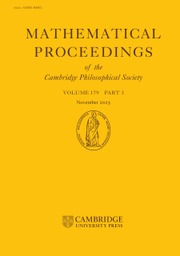The probability distribution of gene-differences in relation to selection, mutation, and random extinction
Published online by Cambridge University Press: 24 October 2008
Extract
In order to determine the mathematical form of the distribution of gene frequencies in a population, R. A. Fisher (1, 2) applied two different but complementary methods. First, differential equations were set up for certain cases and solved. An extension of these results arose from the expression by Wright (10,11,12) of the conditions as an integral equation. But strictly, neither integral nor differential equations can represent the conditions exactly, since integration is substituted for summation, and differentials for minimum steps (1/2n) in gene frequency. The second method employed by Fisher was exact, even though the solutions involved new functions. The properties of generating functions were utilized to yield functional equations, and the special case of rare mutations was dealt with in detail. In the present paper this powerful method is extended to the general case where mutation rates are not necessarily small.
- Type
- Research Article
- Information
- Mathematical Proceedings of the Cambridge Philosophical Society , Volume 45 , Issue 3 , July 1949 , pp. 364 - 367
- Copyright
- Copyright © Cambridge Philosophical Society 1949
References
REFERENCES
- 13
- Cited by


